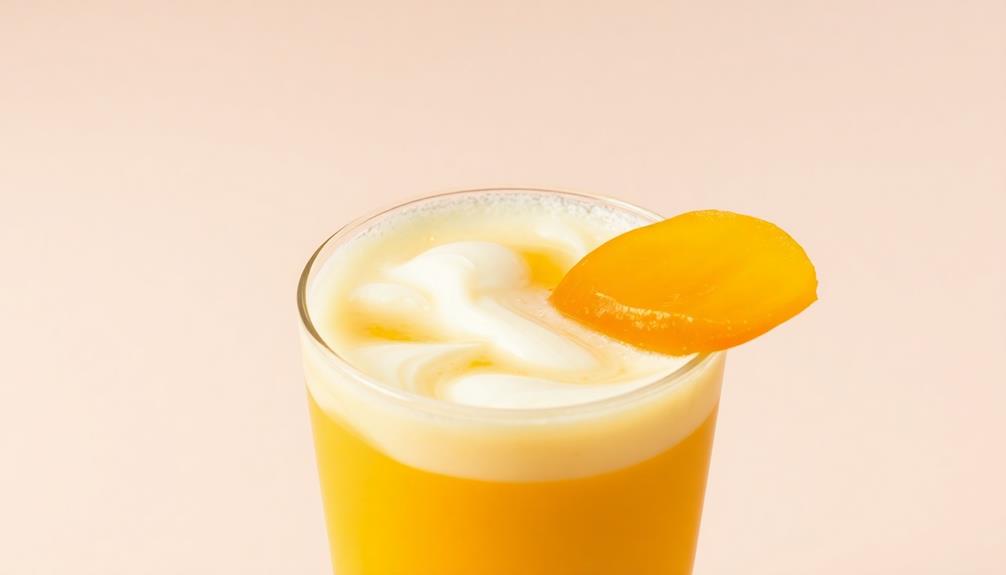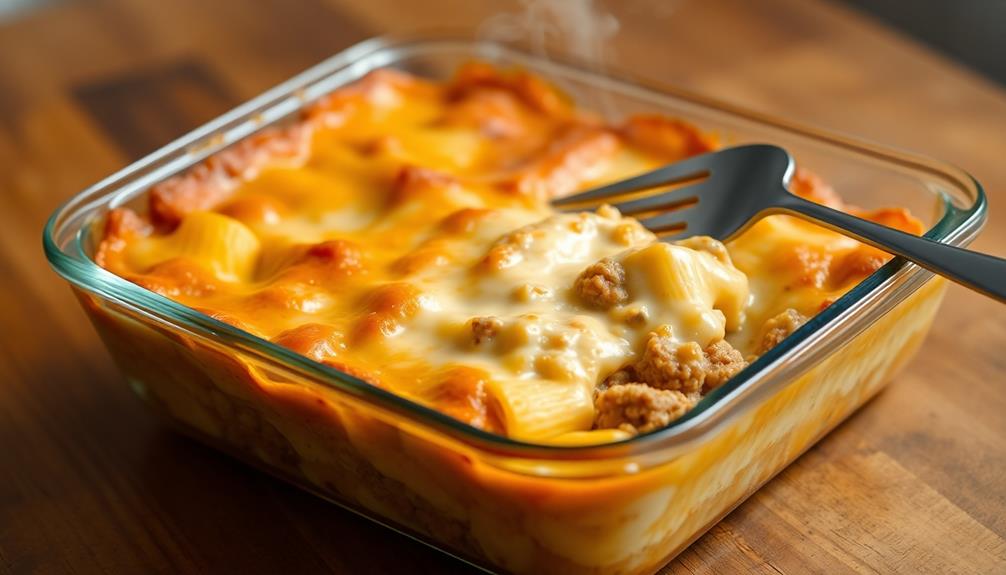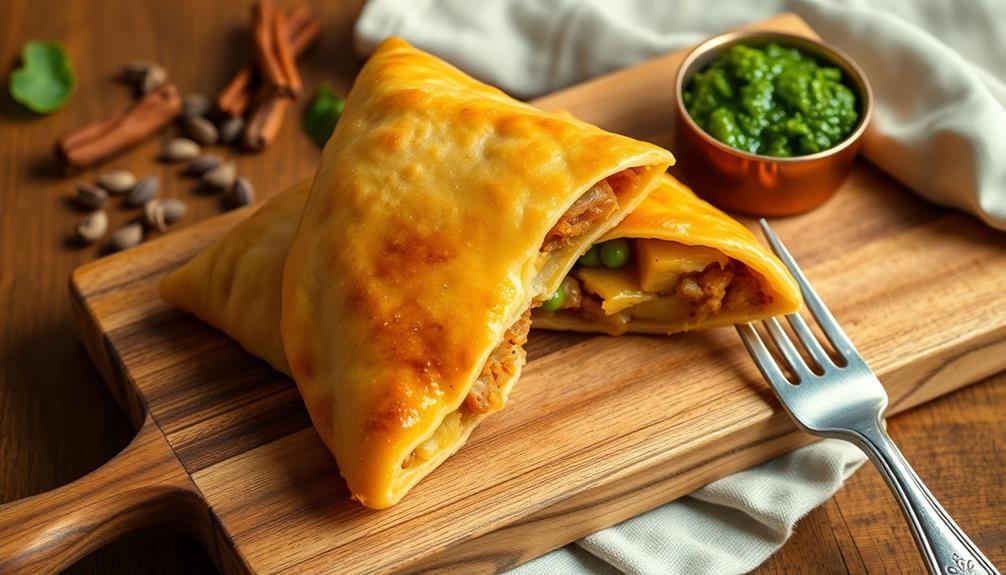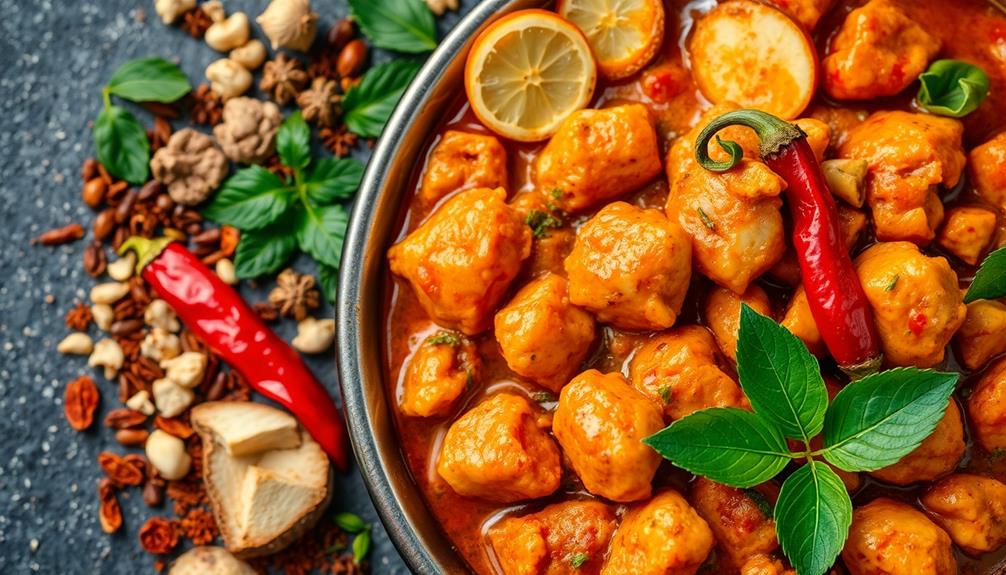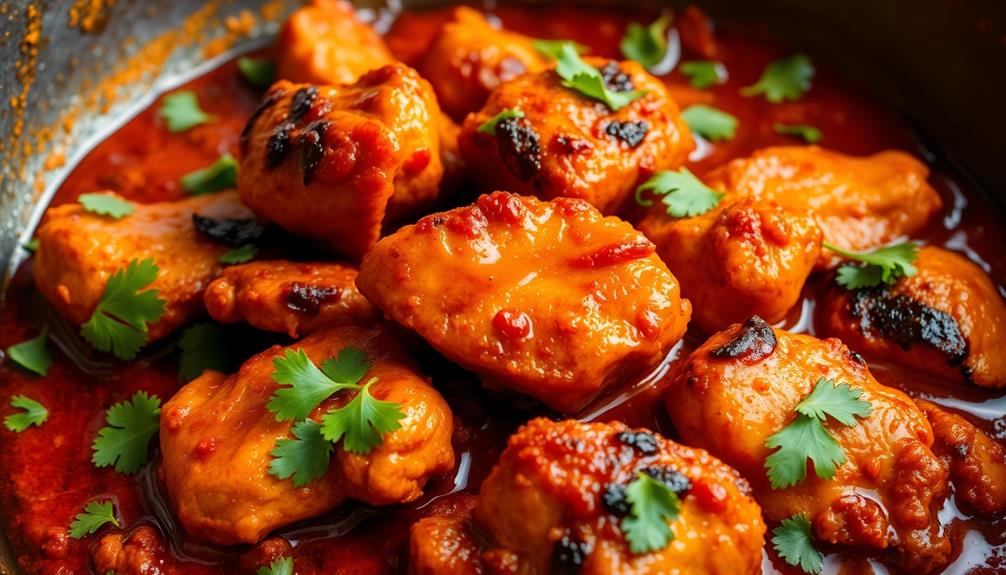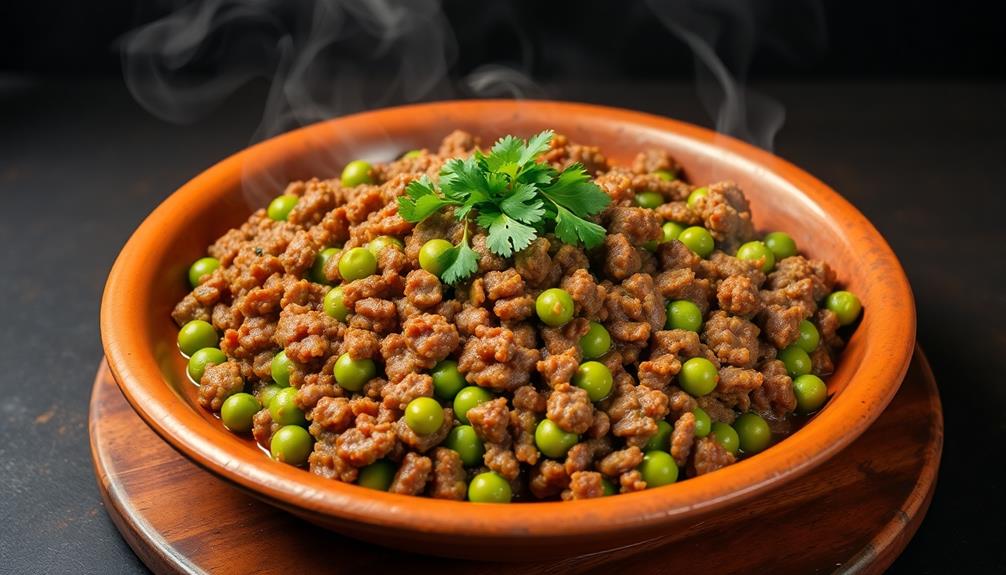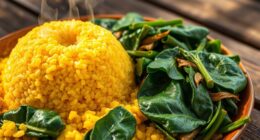Mango lassi is a delightfully refreshing yogurt-based drink that'll whisk you away to a tropical oasis. With its irresistible blend of sweet, ripe mangoes and tangy yogurt, it's the perfect thirst-quenching treat for hot summer days. You'll love how the creamy texture and aromatic spices like cardamom and ginger come together for a truly satisfying sip. It's easy to make at home – just blend up the ingredients, add some ice, and voila! Top it off with a sprinkle of crunchy pistachios for a beautiful presentation. If you're craving a taste of South Asian culture, mango lassi is a must-try.
Key Takeaways
- Mango Lassi is a traditional South Asian yogurt-based beverage that has evolved to incorporate the flavor of ripe mangoes.
- The recipe includes blending mango, yogurt, milk, sugar, and spices like cardamom and ginger for a creamy, sweet, and refreshing drink.
- Serving suggestions include garnishing with chopped pistachios for added crunch and texture, and pairing with other desserts.
- Mango Lassi is versatile and can be customized to suit individual taste preferences, such as adjusting the amounts of mango, milk, or yogurt.
- Proper chilling of the drink enhances the overall satisfaction and refreshing experience, making it a popular choice for hot days.
History
Although the exact origins of mango lassi are unclear, it's believed to have roots in the traditional South Asian yogurt-based beverage known as 'lassi'. This refreshing drink has been enjoyed for centuries, with its cool, creamy texture and natural sweetness from ripe mangoes.
As with maximizing IRA contributions, the recipe evolved over time, incorporating the vibrant flavors of this beloved tropical fruit. As the popularity of mango lassi spread, it became a beloved summertime treat, quenching thirst and delighting taste buds across the region.
Today, this delightful concoction is savored worldwide, offering a taste of South Asian culture in every sip. Whether you're cooling off on a hot day or seeking a sweet and tangy delight, mango lassi is sure to transport you to a world of refreshing flavors.
Recipe
Mango Lassi is a refreshing and creamy Indian drink made with ripe mangoes, yogurt, and a few simple spices. This vibrant beverage is the perfect way to cool down on a hot day and enjoy the sweet, tangy flavors of one of the world's most beloved tropical fruits. For an added touch, some people like to garnish their Mango Lassi with a sprinkle of ground cardamom or a sprig of fresh mint. It can also be served alongside a spicy Indian meal to help balance out the heat of the dishes. If you’re looking for a tasty accompaniment to your Mango Lassi, try out this delicious malai kebab recipe that pairs perfectly with the refreshing flavors of the drink.
Cherished for centuries, mango lassi isn't just a drink but also a cultural experience that highlights the rich culinary traditions of the Indian subcontinent. Originating from the Indian subcontinent, mango lassi is a popular summer staple, often served as a refreshing accompaniment to spicy curries or as a stand-alone treat.
The combination of juicy mangoes, tangy yogurt, and aromatic spices creates a harmonious balance of flavors that's both nourishing and delightful.
- 2 cups ripe mango, peeled and diced
- 2 cups plain yogurt
- 1/2 cup cold milk
- 2-3 tablespoons sugar (or to taste)
- 1/2 teaspoon ground cardamom
- 1/4 teaspoon ground ginger
- Crushed ice (optional)
In a blender, combine the diced mango, yogurt, milk, sugar, cardamom, and ginger. Blend until smooth and creamy. Taste and adjust sweetness as needed. If desired, add a few cubes of crushed ice to chill the lassi further. Pour into glasses and serve immediately, garnished with a slice of fresh mango or a sprinkle of cardamom, if desired.
For best results, use ripe and flavorful mangoes. If the mangoes aren't very sweet, you may need to adjust the amount of sugar to your taste.
The cardamom and ginger provide a subtle, aromatic touch that complements the mango beautifully. Enjoy this refreshing mango lassi as a cooling and nourishing treat on a hot day.
Cooking Steps
Start by blending fresh, juicy mango with cool, creamy yogurt in your blender.
For a delightful twist, consider adding a splash of fresh lime juice to enhance the flavor profile, as citrus fruits can add brightness to your drink.
Next, toss in a handful of ice cubes to chill the mixture.
Don't forget to stir in a pinch of fragrant cardamom and a sprinkle of sweet sugar to balance the flavors.
For more inspiration, explore unique combinations that enhance flavor profiles and nutritional value.
Step 1. Blend Fresh Mango With Yogurt
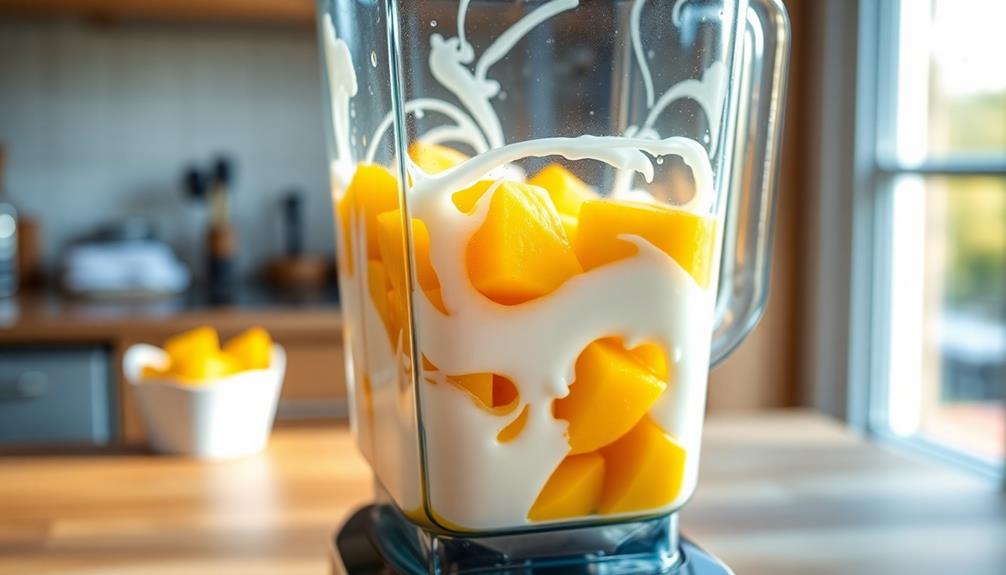
To blend the fresh mango with yogurt, start by peeling and dicing the mango. You'll want about 1 cup of diced mango.
Next, add the mango to a blender along with 1 cup of plain yogurt. For a smooth and creamy texture, you can use Greek yogurt or regular plain yogurt. To enhance the refreshing flavor of your mango lassi, consider incorporating a few drops of essential oils for respiratory health like peppermint or eucalyptus, which can add a hint of freshness.
Now, turn on the blender and blend the mango and yogurt together until it's smooth and creamy. You may need to stop the blender and scrape down the sides a few times to make sure everything gets blended evenly.
Once the mango lassi is blended, you can taste it and add a bit of sugar or honey if you'd like it a little sweeter. Start with just a teaspoon and blend again. Keep tasting and adjusting the sweetness until it's just right for your taste.
Step 2. Add Ice Cubes

After blending the mango and yogurt, you can add a few ice cubes to the mixture. This will help to chill the lassi and give it a refreshing, icy texture.
You can also consider adding a splash of milk or a dollop of whipped cream for an extra creamy touch, reminiscent of the smoothness found in a unique twist on cake. Simply drop in 3-4 standard ice cubes and give it a quick stir. The ice will quickly chill the lassi, making it the perfect sip for a hot day.
You can adjust the amount of ice to suit your personal preference. If you like your lassi extra cold, feel free to add a few more cubes. Just be sure not to overdo it, as too much ice can water down the delicious mango flavor. Stir gently to incorporate the ice without crushing it.
Once the lassi is nicely chilled, it's ready to serve. Pour it into your favorite glass and enjoy the refreshing combination of sweet mango and tangy yogurt, with a delightful icy finish.
Step 3. Stir in Cardamom and Sugar
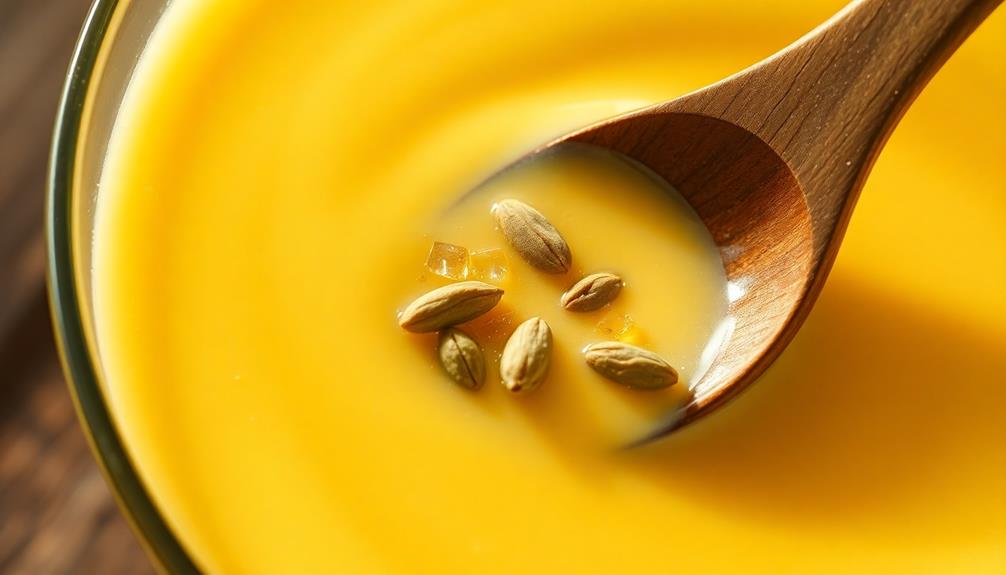
With a few simple additions, you can elevate the flavor of your mango lassi to new heights. Stir in a pinch of fragrant cardamom pods, gently crushing them with the back of a spoon to release their aromatic oils. The warm, slightly minty notes of cardamom complement the sweet, tropical mango perfectly.
Additionally, incorporating natural sweeteners can enhance the overall health benefits of your drink, making it a refreshing option alongside juice diets.
Next, add a spoonful or two of granulated sugar, to taste. The sugar will balance the tartness of the yogurt and enhance the natural sweetness of the mango. Stir the cardamom and sugar into the lassi until they're fully incorporated, creating a harmonious blend of flavors.
The cardamom and sugar work together to transform your mango lassi into a truly indulgent and flavorful treat. Sip and savor the deep, complex layers of taste in each refreshing sip. This simple step takes your lassi from good to absolutely divine!
Step 4. Garnish With Chopped Pistachios
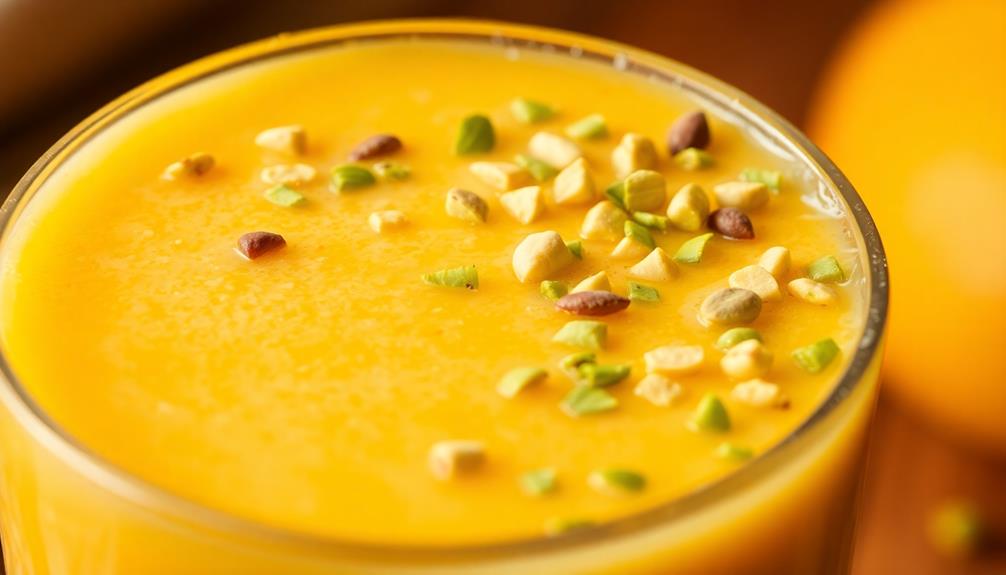
A handful of chopped pistachios make for a delightful garnish, adding a crunchy texture and earthy flavor that complements the sweet and creamy mango lassi.
Pistachios are the perfect topping, adding a vibrant pop of green color that makes this refreshing drink even more visually appealing. The process of creating a smooth and velvety texture in your lassi can be enhanced by ensuring all ingredients are well-blended, similar to the operation and functionality of airless sprayers, which utilize high pressure for smooth finishes.
Simply sprinkle a generous amount of the finely chopped nuts over the top of your prepared lassi, distributing them evenly across the surface. The slight saltiness of the pistachios creates a pleasant contrast, while their crunch provides an enjoyable contrast to the smooth, velvety texture of the mango-infused yogurt drink.
Not only do the pistachios look fantastic, but they also lend a satisfying taste and mouthfeel that takes this mango lassi to the next level. Garnishing your mango lassi with chopped pistachios is the perfect finishing touch, elevating this beloved Indian beverage into a truly delightful and memorable treat.
Step 5. Serve Chilled
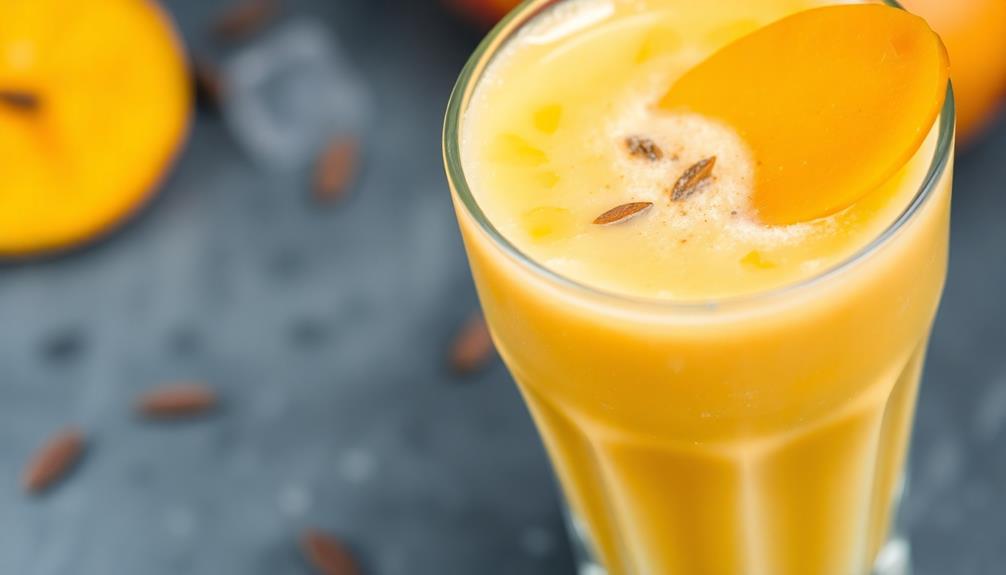
Serve the mango lassi chilled for a refreshing and invigorating experience. Once you've blended the ingredients to perfection, pour the smooth, creamy mixture into glasses or mason jars.
Pop them in the fridge for at least 30 minutes to chill thoroughly. This will ensure the lassi is nicely cooled, allowing the flavors to shine. Additionally, the probiotics from yogurt can support gut health, making this drink not only delicious but also beneficial for digestion, similar to aloe vera's digestive aid.
When you're ready to serve, you can garnish the chilled lassi with a sprinkle of chopped pistachios for a delightful crunch and pop of color.
The cool, velvety texture paired with the mango's sweet tanginess and the nuts' earthy nuttiness creates an amazingly refreshing and well-balanced drink. Sip and savor every last drop – the mango lassi is sure to transport you to a sunny, tropical oasis with each refreshing sip.
Enjoy this chilled delight on a hot day or anytime you need a little taste of paradise.
Final Thoughts
Ultimately, mango lassi is a refreshing and versatile drink that can be enjoyed in a variety of ways. You can tweak the recipe to suit your taste buds, adding more or less mango, milk, or yogurt.
For a dessert twist, consider pairing it with a scoop of Birthday Cake Ice Cream for a delightful fusion of flavors. Don't be afraid to experiment! You might even try swirling in a touch of honey or a sprinkle of cardamom for an extra flavor boost.
When serving, don't forget to chill your lassi thoroughly for the most satisfying experience. The cool, creamy texture is simply divine on a hot day.
Garnish with a fresh mango slice or a sprinkle of ground pistachios for a beautiful presentation that's sure to impress your friends and family.
Whether you're looking for a refreshing breakfast, a midday pick-me-up, or a soothing after-dinner treat, mango lassi is the perfect choice. Embrace its versatility and enjoy this delightful drink any time of day!
Frequently Asked Questions
What Is the Shelf Life of Homemade Mango Lassi?
Homemade mango lassi generally has a shelf life of 3-5 days when stored in the refrigerator. The high acidity and low pH of the yogurt and mango help preserve the drink, but it's best consumed within a few days for optimal freshness and flavor.
Can Mango Lassi Be Frozen?
Yes, you can freeze mango lassi. It'll keep in the freezer for up to 2 months. Just be sure to thaw it in the fridge before serving for the best texture and flavor.
How Can I Make Mango Lassi Lactose-Free?
To make your mango lassi lactose-free, simply swap out regular milk for lactose-free milk or a non-dairy milk alternative like almond, coconut, or soy milk. This will allow you to enjoy the creamy, fruity flavor without the lactose.
Is Mango Lassi Suitable for a Vegan Diet?
Yes, mango lassi can be suitable for a vegan diet. You can make it with plant-based milk alternatives like almond, coconut, or oat milk instead of traditional dairy. Just blend the mango, plant-based milk, and any other desired ingredients for a delicious vegan treat.
Can Mango Lassi Be Made With Fresh or Canned Mangoes?
You can make mango lassi using either fresh or canned mangoes. Both options work well, and the choice often comes down to personal preference and availability of ingredients. The key is using ripe, sweet mangoes for the best flavor.
